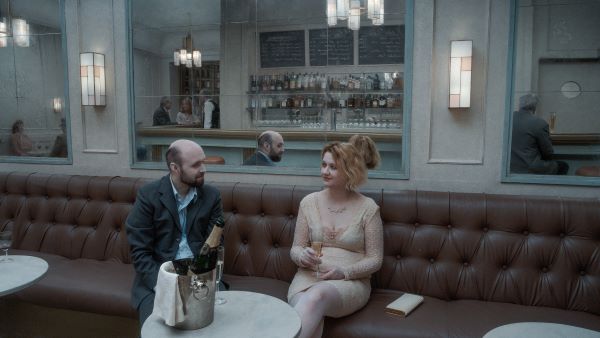
Six years after his bizarre masterpiece, A Pigeon Sat on a Branch Reflecting on Existence, Swedish auteur Roy Andersson is back with About Endlessness, a reprise of his treasured stylistic touches: intriguing stasis, painterly references, elaborate artifice, and a sense of timeless absurdity. Only this time Andersson offers up fewer fey gags like Pigeon’s silly “Uncle One-Tooth’’ novelty toy and instead provides more grim set pieces with overtones of evil and disaster. The result: About Endlessness is as dark as the dirt under a witch’s fingernails.
Like the last go-round, Andersson presents a series of vignettes that first look like independent stories, but which we gradually realize are interrelated. Pale, haggard people, often middle-aged men, gaze into the middle distance or declaim to the screen over washed-out backdrops, sharing troubles and sorrows.
One recurring theme features a priest undergoing a loss of faith, drinking out of view of his parishioners, and, in a touch of morbid Anderssonian satire, being shooed away by a too-busy-to-be-bothered therapist and his secretary at the cleric’s peak moment of crisis. We later realize why this man of the cloth may be in such pain; shades of contemporary war linger in a scene of parents mourning their dead child in a graveyard and in an unbearably sad tableau in which a legless veteran plays a mandolin in a subway for uncaring passersby.
The director employs a female narrator who intones enticing narrative fragments, such as “I saw a woman, a communications manager, incapable of feeling shame” (cue woman staring out a window into a bleak cityscape). Without providing any explanations, the voice-over sketches out scenes such as a lonely man hiding money under a dirty mattress or a woman drinking champagne in a hotel bar in a possible paid assignation. Tensions escalate: a plain man slaps his lover in another hotel bar in an act of unlikely passion. On the other hand, a trio of present-day young women break out and dance to goofy 1950s music, providing much-needed comic relief.
But it doesn’t take long for the film to ramp up into misery, with scenes of religious flagellation and a modern-day apartment honor killing moving onto images of Nazism and prisoners of war marching to certain deaths across a snowy plain. Throughout, characters complain about slights, disappointments, disillusionment, the small injuries of life which Andersson relates to a greater, crueler whole.
The director’s eye-catching set pieces still cast a spell, and the formal control still elicits admiration, but the bleakness of the vision leaves a sting like a freezer burn.
